Whenever people walk on the beach, they invariably look down as they walk hoping to, perhaps, find that elusive, aged trunk of pirated treasures, a “message in a bottle” tossed from a ship a half century or more ago, or at least sea glass and beautiful shells churned up by raging storms.
Sadly, more often than not, what they will find is debris—including plastic bottles and caps; rope; broken and derelict fishing equipment; lighters; toothbrushes; Styrofoam; and cans—all litter dumped directly onto beaches or into the ocean, and all of which is dangerous and potentially deadly to marine wildlife.
A creative public awareness campaign called Washed Ashore uses sculptures created from trash and marine debris to illustrate how much pollution washes ashore each day on planet earth. According to the Ocean Conservancy’s research partners, nearly 35 million metric tons of plastic entered the global aquatic ecosystems in 2020.
The Oregon-based nonprofit has exhibited their giant sculptures at the Smithsonian National Museum of Natural History in Washington, on The Kelly Clarkson Show, at Disney venues, and at many zoos, aquariums and botanical gardens across the United States.
And now, Washed Ashore’s traveling art exhibit has come to Galveston Island. Washed Ashore has partnered with Galveston’s Park Board to bring more than 20 sculptures crafted from debris collected from beaches to Galveston through March 5.
The Park Board will also work with Washed Ashore representatives to establish an artist residency program designed to instruct local community partners about crafting permanent art items, said Mary Beth Bassett, senior public relations manager at Visit Galveston, the tourism arm of the Park Board.
“Washed Ashore and its work is important to Galveston because the island is home to 32 miles of beaches—its most important natural asset and most important tourism draw,” Bassett said.
“The Park Board’s Coastal Zone Management employees—beach cleaning team— collects more than two million pounds of trash along Galveston’s beaches each year. The trash and litter that washes up on Galveston’s beaches diminishes the beachgoers’ experience, but more important, it harms the coastal ecosystem. Both residents and visitors who spend time at the beach should expect clean shores. Bringing Washed Ashore sculptures here is a visual reminder that everyone bears a responsibility to keep the environment clean.”
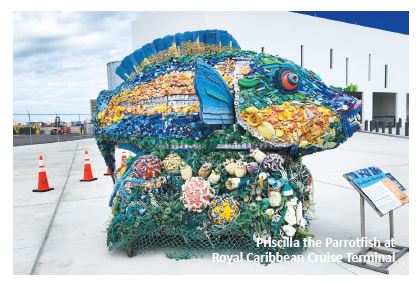 Its Galveston debut marks the first time the Washed Ashore exhibit will not be behind a paid gate in the U.S., she said.
Its Galveston debut marks the first time the Washed Ashore exhibit will not be behind a paid gate in the U.S., she said.
“Up to now, most of the Washed Ashore exhibits have been inside paid gates, like zoos and museums,” Bassett said, adding the traveling exhibit is a perfect fit for the island, which relies on Galveston’s bountiful natural beauty to keep the wave of tourism dollars coming to local businesses.
From a distance, the sculptures are impressive, but when seen up close, it can be an eye-opening experience, she said.
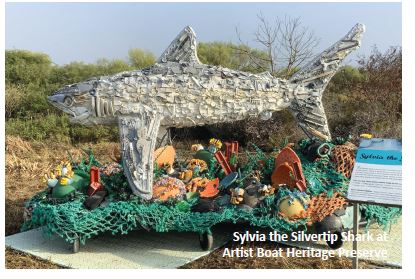 “The sculptures are truly works of art. For example, Octavia the Octopus on display in Saengerfest Park, is a massive statue comprised of mostly red items. There are plenty of bottle caps that resemble the suction cups. It sits atop larger plastic items like beach chairs and tires. It is mostly red and orange in color and there’s no doubting it’s an octopus.”
“The sculptures are truly works of art. For example, Octavia the Octopus on display in Saengerfest Park, is a massive statue comprised of mostly red items. There are plenty of bottle caps that resemble the suction cups. It sits atop larger plastic items like beach chairs and tires. It is mostly red and orange in color and there’s no doubting it’s an octopus.”
The aim is to educate the public about the importance of limiting what winds up in our oceans and waterways, and it all comes down to taking some personal responsibility.
“People can view the sculptures and really take them in. When you see each piece, you realize your responsibility in keeping the coastal environment clean. You can also donate to causes like Washed Ashore or any local conservation organization. There are several that organize beach cleanups throughout the year,” she said.
A recent study funded by the National Oceanic and Atmospheric Administration’s Office Marine Debris Program and led by the Ocean Conservancy and the Commonwealth Scientific and Industrial Research Organisation of Australia found that between 20 million and 1.8 billion marine debris items can be found along the shoreline of the continental United States at any given moment.
The Gulf of Mexico, a basin in the Atlantic Ocean that is surrounded by the gulf coast of the United States, Mexico, and Cuba, is the world’s largest gulf. It is a productive biodiverse teeming with life of all kinds. Research has shown that marine debris impacts more than 700 species, from coastal vegetation, to plankton, invertebrates, fish, cetaceans, sea turtles and seabirds.
When wildlife ingests plastics, trash or marine debris, it sets in motion an unfortunate cascade of events: the debris can block their stomach or puncture the inside of their bodies causing serious internal injury to the animal.
Sea turtles often mistake plastic bags and balloons for jellyfish, a natural source of food, and consuming plastic can kill the turtle. When marine life is caught up in discarded fishing nets and crab pots, it can render the animal unable to swim or feed, and it will die an agonizing and unnecessary death.
The food chain is further affected when a bigger animal eats the smaller animal that has consumed plastic. When the plastic that is released into the gut of marine life is absorbed by the hungry predator, the plastic gets passed up the food chain.
The importance of the Gulf of Mexico to the health and sustainability of the planet is immeasurable.
A two-year study in the Gulf of Mexico conducted by a team of researchers from Dauphin Island Sea Lab and the Mission-Aransas National Estuarine Research Reserve found that ocean trash washes up on the shores of Texas at more than 10 times the rate as at other Gulf State locations.
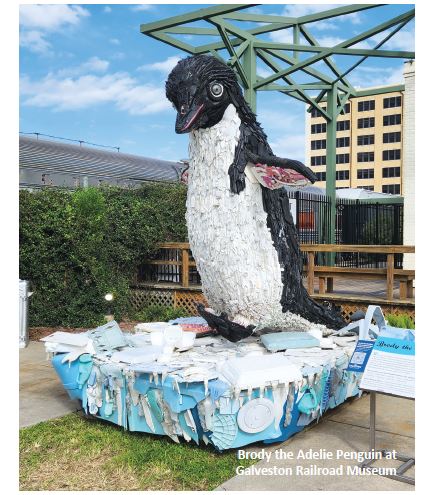 Additionally, the study—published in the February 2018 ScienceDirect journal Marine Pollution Bureau (Volume 139)—reported that plastic composed 69-to 95 percent of debris found in the gulf.
Additionally, the study—published in the February 2018 ScienceDirect journal Marine Pollution Bureau (Volume 139)—reported that plastic composed 69-to 95 percent of debris found in the gulf.
It’s more than an eyesore. It’s an abomination, said local sculptor Mike Quinn, and that’s why the Washed Ashore art installations are so vital in the role of public education, he said.
“The sculpture series is a relevant and compelling way to alert the public to the overwhelming problem of plastic pollution in the Gulf… Being surrounded by water, it's especially important in Galveston,” Quinn said.
Quinn is renowned for his Fish with Attitude series, a line of quirky undersea life, ranging from fish and oysters to crustaceans and other seafaring critters; his Creatures with Attitude, a line of fantastical creatures primarily created using clay; and his Stunt Sculptures, large-scale pieces handcrafted with metals, fiberglass, foam and other materials.
His portfolio includes tribal masks, large-scale fiberglass sculptures, paintings and his smaller collections of sculptures. His custom work often commands more $12,000 per piece, and his work can be found in (and outside) private homes and galleries throughout the world, including at From the HeART Gallery, 2111 Postoffice St., Galveston.
A global traveler, Quinn said he’s heartbroken by the disrespectful way our planet is treated by the public-at-large.
“Plastic pollution is a huge problem globally. In my 56 years on earth, I've been lucky to travel to many places. I've seen the persistent problem of plastic pollution firsthand,” he said.
“On the beaches in Indonesia, on the island of Sumbawa, far from any civilization, the beach trash was horrendous. Trash in the Black Sea and the beaches of Turkey was so bad, I swam only a few times because of all the floating trash. Peru, Mexico, Costa Rica … the plastic pollution is everywhere. Many of these communities actually wait for flooding to throw out the trash so it takes it far away it all ends up floating in the ocean.”
Quinn said he would consider it an honor to be part of the team of Galveston artists to contribute to the Washed Ashore program on the Island.
“Through these art installations we can raise public awareness and get everyone possible working on solutions. This is a great example of how art can make the world a happier, healthier, and better place,” Quinn said.
According to research, an estimated 15 million tons of plastic ends up in the world's waterways each year. Every Washed Ashore sculpture serves as a tactile public service announcement to educate people about the millions of metric tons of trash that enters the ocean through human carelessness or disregard.
Artists who work with the nonprofit are on a personal mission to show people just how much trash is collected from oceans by creating marine life sculpture—from jellyfish, sea turtles and sharks to whales and more—made entirely of plastic pollution directly recovered from oceans.
Kelsey Malan, outreach and marketing coordinator for Galveston’s Artist Boat, said the mission of Washed Ashore is to raise awareness and inspire people to action “to help us fight the war on plastic that our ocean is currently battling.”
Malan said, “They say a garbage truck worth of plastic is emptied into the ocean every minute, and one of the top ways it is getting there is from runoff from the land. Galveston Bay is an estuary, getting all the runoff and rainwater from both the San Jacinto River and the Trinity River.”
“These are two major rivers in Texas; the Trinity River alone encompasses 70 percent of the Texas population within its watershed. That means that the litter, oil from cars, landfill runoff, microfibers from drains, and many other sources from 70 percent of Texas residents ends up right here in our bay,” Malan added.
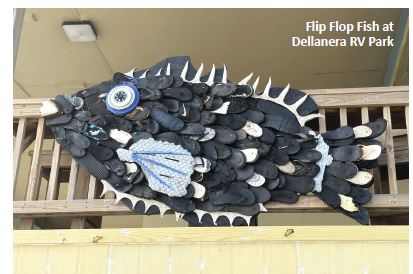 The runoff from the San Jacinto and the Trinity rivers makes Galveston Bay Estuary the seventh largest estuary in the U.S., “allowing us to have the second most productive fishery in the U.S.,” she said.
The runoff from the San Jacinto and the Trinity rivers makes Galveston Bay Estuary the seventh largest estuary in the U.S., “allowing us to have the second most productive fishery in the U.S.,” she said.
“But the fisheries are already so polluted that every level of the ocean food chain and one-quarter of all fish contain plastic in their bodies already, and there is no end in sight to the heaps of plastic. It is not too late, but if we do not act soon to start fighting against plastic it might be.”
Malan said people can do more than they think just by being more aware when shopping.
“Reduce, reuse, recycle, and refuse plastic. This means buying alternatives to plastic and not littering. People can also help by just supporting organizations fighting to eliminate and create alternatives to plastic,” she said.
“Humans ingest enough plastic to produce a credit card each week. We consume it in every plastic water bottle or food container, salt, beer, tap water, and even in the air we breathe. Things are much worse than many people realize, and we need to start talking about it to start making change happen.”
Malan said she hopes Artist Boat—which, like Washed Ashore, is a nonprofit organization dedicated to promoting awareness and preservation of the marine environment—will be part of the Washed Ashore project in the months ahead.
“Currently, we are still in Phase 1 of spreading the word about the visiting Washed Ashore sculptures,” she said.
“The Park Board of Trustees will be meeting with the Washed Ashore team to discuss logistics of creating our own Galveston Resident sculptures. Building those will be Phase 2 to this project and will be discussed further in the future. Artist Boat would love to be involved with creating one of these.”
The waters and marine life off the coast of Galveston Island are vulnerable to pollution and discarded trash, and even the Flower Garden Banks National Marine Sanctuary, located off-shore, is not safe.
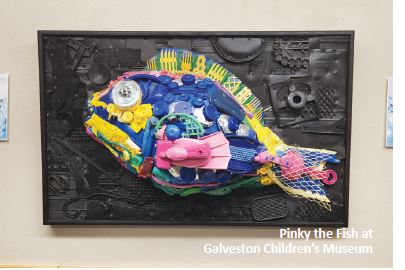 The sanctuary, situated off the coasts of Texas and Louisiana, is one of 14 federally designated underwater areas protected by NOAA’s National Marine Sanctuaries.
The sanctuary, situated off the coasts of Texas and Louisiana, is one of 14 federally designated underwater areas protected by NOAA’s National Marine Sanctuaries.
“Because Flower Garden Banks National Marine Sanctuary is located 80-to 125 miles from shore, we don't see as much marine debris as other places close to land, but that doesn't mean the sanctuary is immune,” said Kelly L. Drinnen, education and outreach specialist for the Sanctuary.
“We have seen occasional beverage cans and other odd items on the bottom, in both shallow and deep areas. Recent studies have also shown the presence of microscopic bits of plastic in water samples from the sanctuary. That means that although we may not be seeing much actual debris, plastics are breaking down and finding their way far offshore. These tiny bits are unknowingly eaten by plankton-feeding organisms, then continue to work their way up the food chain as those organisms are eaten by ever larger ones.”
In addition to harming marine life and coral, lost or abandoned fishing nets, lines, crab/shrimp pots, and other recreational or commercial fishing equipment can be a hazard to navigation.
“The challenge with nets and lines is that they get caught and scrape across the reef structure, damaging important habitat for a variety of sea life. They may also continue to capture wildlife for many years to come. Anchors, on the other hand, do most of their damage on impact. In one instant, they can break corals that have taken hundreds of years to grow,” she said. “This is why anchoring is completely prohibited in the sanctuary.”
Drinnen said she’s familiar with the mission of Washed Ashore and has seen the traveling exhibit several times at different locations, usually at zoos or aquariums.
“So far, I've just had a chance to see Greta the Great White Shark, here in Galveston. The art itself is amazing, but the source material makes me sad. I could clearly see beach toys, baskets, pieces of shoes, broken buoys, plastic containers, and more. These are all things I've found on Galveston beaches before—I've just never seen them displayed in this manner. Hopefully, when others see these sculptures, they'll have similar thoughts and will consider what they might do to help solve the problem.”
Drinnen said it all comes down to people either having respect for their home planet and for other life forms that inhabit earth, or not having that respect.
“People tend to have a blind spot where trash is concerned. If they can't see it, it's no longer a problem. Unfortunately, out of sight doesn't mean gone. It just means the problem has moved elsewhere,” she said.
“We need to get better at reducing the amount of waste we create and finding ways to manage it responsibly. Recycling is a start, but it goes beyond that. We need to be more mindful about what we do and how we do it.”
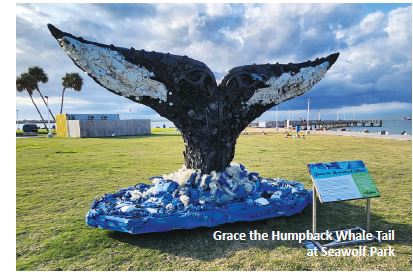 “Here's another way to think about it: Water is essential to all forms of life. In addition, all the water we will ever have is already on this planet; it just keeps moving around through the water cycle. So, the water in the storm drains or flowing through a stream may someday be part of the water you drink or the place you swim. We need to remember that. We shouldn't have to clean our water to use it. We should just keep it clean to start with,” Drinnen added.
“Here's another way to think about it: Water is essential to all forms of life. In addition, all the water we will ever have is already on this planet; it just keeps moving around through the water cycle. So, the water in the storm drains or flowing through a stream may someday be part of the water you drink or the place you swim. We need to remember that. We shouldn't have to clean our water to use it. We should just keep it clean to start with,” Drinnen added.
She said the Washed Ashore program is a great way to underscore the problem, capture the attention of the public, and spur people on to make much-needed changes.
“The purpose of the Washed Ashore exhibit is to highlight the amount of trash being found on our shores. The fact that these gigantic sculptures can be created from objects found on beaches shows just how big a problem we have,” she said.
“Galvestonians should care because the same thing is happening on our beaches. Beach cleanups are not enough, we need to prevent the plastics from getting there in the first place.”
Installation of the Washed Away sculptures in Galveston began on December 5, 2022 and will continue through March 5, 2023. For more images of the sculptures that are on display, go to visitgalveston.com.
Explore Washed Ashore & Win! The Washed Ashore experience in Galveston is like an island-wide scavenger hunt. Not only can residents and visitors search for the 20+ art pieces, but everyone can also find unique things hidden within every sculpture.
And those who participate in the Washed Ashore Scavenger Hunt Challenge and/or the #WashedAshoreGTX Social Media Sweepstakes can win special prizes.
#WashedAshoreGTX Social Media Sweepstakes Take a picture of you and the sculpture(s), share it on Instagram using #WashedAshoreGTX plus tagging @GalvestonIsland, and be entered into a sweepstakes to win prizes, including hotel stays, attraction passes and more. Anyone that doesn't have an Instagram account can still participate by uploading their images to visitgalveston.com.
In January and February during the Washed Ashore exhibit in Galveston, three lucky participants will be entered in for a chance to win the prizes. Winners will be selected at random.
JANUARY PRIZES:
1st Place: One-night stay at The Tremont House + VIP Attraction Passes
2nd Place: VIP Attraction Passes
3rd Place: Galveston Swag Bag
FEBRUARY PRIZES:
1st Place: One-night stay at The San Luis Resort + VIP Attraction Passes
2nd Place: VIP Attraction Passes
3rd Place: Galveston Swag Bag
Washed Ashore Scavenger Hunt Challenge
Check in at nine or more locations on the Visit Galveston app to win Galveston Island swag. Once you've completed the challenge, pick up your gift from the Visitor Information Center located in downtown Galveston at 2228 Mechanic, Suite 200.
The Washed Ashore Scavenger Hunt Challenge is only available on the Visit Galveston app in the Apple App Store and Google Play Store.